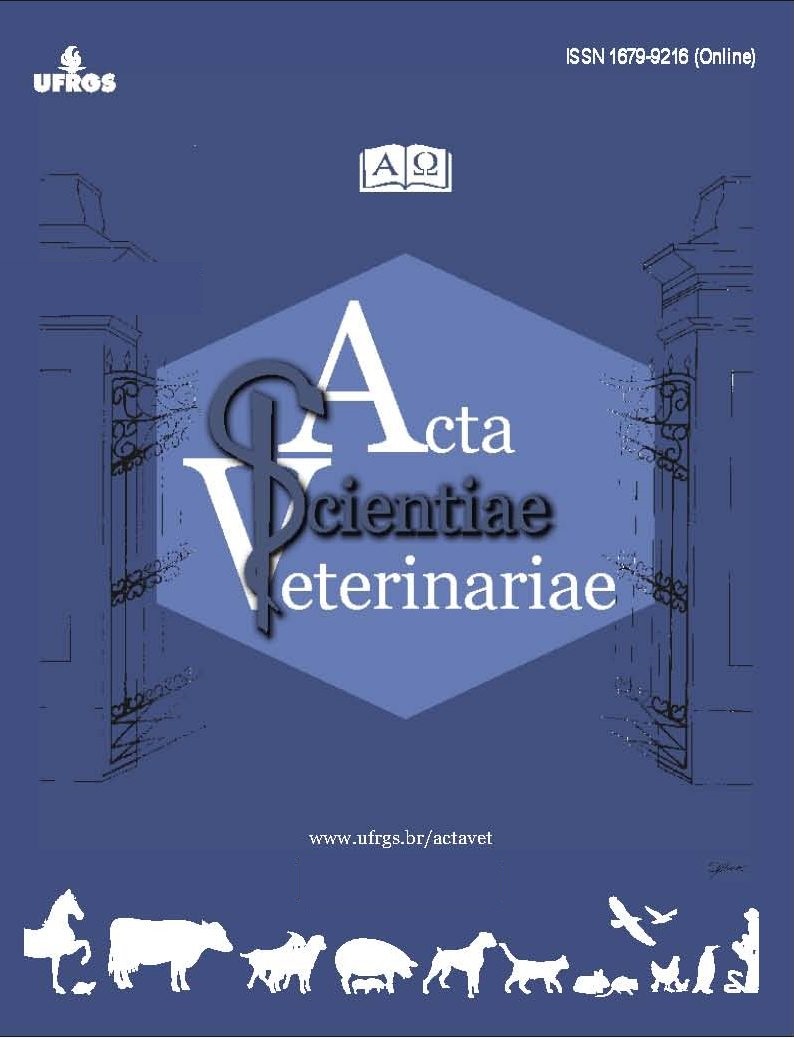Mesenteric hernia with intestinal incarceration in a dog
DOI:
https://doi.org/10.22456/1679-9216.136593Palavras-chave:
canine, hernia, mesentery, necropsy, pathologyResumo
Background: Mesenteric hernia is a pathological condition characterized by the protrusion of the viscera, usually some portion of the small intestine, that moves through an abnormal opening in the mesentery. It can be either caused by a congenital problem or acquired through severe trauma or after surgery in the region. This type of internal hernia is considered extremely rare and has not been extensively studied in the veterinary field. Thus, the aim of this study was to describe the main macroscopic characteristics of an unusual mesenteric hernia encountered in a dog.
Case: A 2-year-old Lhasa Apso dog, which had a medical history of epilepsy but had not exhibited seizures for at least a year, was restless and had a lot of intestinal noises at home, as reported by the owner. Given these concerning symptoms, the dog was immediately taken to the Medical University Complex of the Ritter dos Reis University Center (UniRitter). However, on the way to the center, the animal succumbed to a seizure and subsequently died. The dog was then sent for necropsy and proper analysis. On external examination, the corpse had pale mucous membranes and a rigid abdomen with increased volume. Upon opening the abdominal cavity, the intestinal loops showed signs of strangulation with severe congestion, were hemorrhagic, and displayed hypercolored, ischemic, and necrotic areas. These characteristics, in addition to the visible hanging of the intestinal loops that moved due to the mesenteric defect and caused intestinal obstruction, were indicative of mesenteric hernia. Given that the dog did not undergo any abdominal surgery or suffered severe trauma, the pathology may have been caused by congenital malformation, although it cannot be confirmed since the congenital etiology of this disease is still unknown in veterinary medicine.
Discussion: Mesenteric hernias are known to occur possibly as a result of trauma or surgery in the region or due to a congenital problem, consequently leading to malformation in the mesentery that results in the incarceration of viscera in the region. Considering that the dog was young, did not undergo any surgery in the region or experience any trauma, only had a history of epilepsy, and did not experience seizures for a year, a congenital mesenteric defect was suspected. While still alive, the diagnosis can be made through an ultrasound but can only be confirmed through laparotomy as the possible symptoms are nonspecific, including emesis, abdominal pain, fever, pale mucous membranes, dehydration, dysorexia, diarrhea, and increased abdominal volume. In addition to the nonspecificity of the symptoms, they can also vary on a case-by-case basis. However, the condition of the dog reported here was not examined before death. It is difficult to establish a more specific etiology for the present case due to the lack of reports on this disease in the field of veterinary medicine. Thus, an in-depth review of case reports about this disease in the field of human medicine needs to be thoroughly conducted. Although there are many cases of other types of hernias in veterinary medicine, mesenteric hernia is a rare pathology and has not been sufficiently studied. An extensive bibliographical search identified only one recently published article about a dog of the same breed. This suggests that there is a scarcity of reports about this pathology in dogs.
Downloads
Referências
Byard R.W. & Wick R. 2008. Congenital mesenteric defects and unexpected death-a rare finding at autopsy. Pediatric and Developmental Pathology. 11(3): 245-248. DOI: 10.2350/07-12-0392.1. DOI: https://doi.org/10.2350/07-12-0392.1
Diniz J.B.O, Nadine A.M., Klaus C.S., Dirceu G.S.R., Ana Vitória A.S. & Dyomar T.L. 2020. Torção intestinal pelo aprisionamento em mesentério em cão: Relato de caso. Brazilian Journal of Health Review. 3(6). 19327-19331. DOI: 10.34119/bjhrv3n6-312. DOI: https://doi.org/10.34119/bjhrv3n6-312
Guedes R.M.C., Brown C.C., Sequeira J.L. & Reis Jr J.L. 2016. Sistema Digestório. In: Santos R.L. & Alessi A.C. (Eds). Patologia Veterinária 2.ed. Rio de Janeiro: Grupo GEN, pp.86-180.
Redolfi G. & Grand J.G. 2023. Congenital trans-mesenteric hernia as a cause of small intestine strangulation in a dog. Revue Vétérinaire Clinique. 58(1): 27-31. DOI: https://doi.org/10.1016/j.anicom.2023.01.005
Swift I. 2009. Ultrasonographic features of intestinal entrapment in dogs. Veterinary Radiology & Ultrasound. 50(2): 205-207. DOI: 10.1111/j.1740-8261.2009.01518.x. DOI: https://doi.org/10.1111/j.1740-8261.2009.01518.x
Vaos G. & Skondras C. 2007. Treves' field congenital hernias in children: an unsuspected rare cause of acute small bowel obstruction. Pediatric Surgery International. 23(4): 337-342. DOI: 10.1007/s00383-007-1877-y. DOI: https://doi.org/10.1007/s00383-007-1877-y
Arquivos adicionais
Publicado
Como Citar
Edição
Seção
Licença
Copyright (c) 2024 Alice Faé, Larissa Covaleski Gonzalez, Bruna Pioner de Jesus, Beatriz Lopes Simão, Ísis Moukaddem de Souza, Thaís Lima Henriques Maia, Eleonora Camara Ehlers, Ana Carolina Barreto Coelho

Este trabalho está licenciado sob uma licença Creative Commons Attribution 4.0 International License.
This journal provides open access to all of its content on the principle that making research freely available to the public supports a greater global exchange of knowledge. Such access is associated with increased readership and increased citation of an author's work. For more information on this approach, see the Public Knowledge Project and Directory of Open Access Journals.
We define open access journals as journals that use a funding model that does not charge readers or their institutions for access. From the BOAI definition of "open access" we take the right of users to "read, download, copy, distribute, print, search, or link to the full texts of these articles" as mandatory for a journal to be included in the directory.
La Red y Portal Iberoamericano de Revistas Científicas de Veterinaria de Libre Acceso reúne a las principales publicaciones científicas editadas en España, Portugal, Latino América y otros países del ámbito latino





